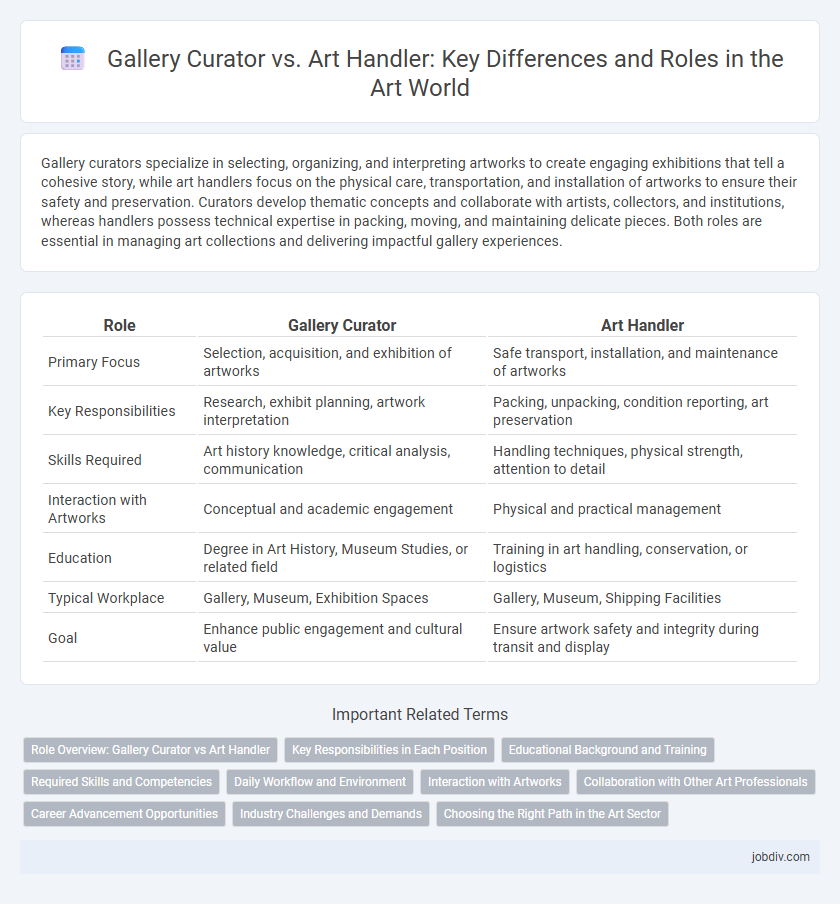Gallery curators specialize in selecting, organizing, and interpreting artworks to create engaging exhibitions that tell a cohesive story, while art handlers focus on the physical care, transportation, and installation of artworks to ensure their safety and preservation. Curators develop thematic concepts and collaborate with artists, collectors, and institutions, whereas handlers possess technical expertise in packing, moving, and maintaining delicate pieces. Both roles are essential in managing art collections and delivering impactful gallery experiences.
Table of Comparison
| Role | Gallery Curator | Art Handler |
|---|---|---|
| Primary Focus | Selection, acquisition, and exhibition of artworks | Safe transport, installation, and maintenance of artworks |
| Key Responsibilities | Research, exhibit planning, artwork interpretation | Packing, unpacking, condition reporting, art preservation |
| Skills Required | Art history knowledge, critical analysis, communication | Handling techniques, physical strength, attention to detail |
| Interaction with Artworks | Conceptual and academic engagement | Physical and practical management |
| Education | Degree in Art History, Museum Studies, or related field | Training in art handling, conservation, or logistics |
| Typical Workplace | Gallery, Museum, Exhibition Spaces | Gallery, Museum, Shipping Facilities |
| Goal | Enhance public engagement and cultural value | Ensure artwork safety and integrity during transit and display |
Role Overview: Gallery Curator vs Art Handler
Gallery curators oversee the acquisition, interpretation, and exhibition of artworks, ensuring the creative and thematic vision aligns with institutional goals. Art handlers specialize in the physical care, packing, transportation, and installation of artworks, prioritizing safety and preservation. Both roles are essential for maintaining the integrity and presentation quality of art collections within gallery settings.
Key Responsibilities in Each Position
Gallery curators oversee the conceptualization and organization of exhibitions, selecting artists and works to align with the gallery's vision while managing budgets and promotional activities. Art handlers specialize in the physical care, installation, and transportation of artworks, ensuring proper handling, packing, and preservation to prevent damage. Both roles require collaboration to maintain the integrity and presentation quality of art collections.
Educational Background and Training
Gallery curators typically hold advanced degrees in art history or fine arts, emphasizing knowledge of art theory, curation, and exhibition planning, often supplemented by internships at museums or galleries. Art handlers usually possess specialized training in the physical care, transportation, and installation of artworks, gaining expertise through vocational programs or on-the-job apprenticeships focused on conservation techniques and handling protocols. The curator's education centers on intellectual engagement with art, while the handler's training prioritizes practical skills essential for preserving and safeguarding valuable pieces during handling and display.
Required Skills and Competencies
Gallery curators require strong expertise in art history, collection management, and exhibition planning, combined with excellent communication skills to engage artists and patrons effectively. Art handlers must possess technical competencies in art installation, packing, and transportation, with careful attention to detail and understanding of conservation standards. Both roles benefit from knowledge of provenance, condition reporting, and collaboration within museum or gallery environments.
Daily Workflow and Environment
Gallery curators manage the daily workflow by organizing exhibitions, researching artists, and coordinating with lenders, while art handlers focus on the physical care, transportation, and installation of artworks within climate-controlled environments. Curators work closely with artists and collectors to develop thematic narratives, ensuring the collection's integrity and audience engagement, whereas art handlers maintain strict protocols to prevent damage and handle conservation-sensitive pieces. The curator's environment is administrative and intellectual, often involving meetings and documentation, contrasting with the art handler's physically demanding and detail-oriented workspace in galleries or storage facilities.
Interaction with Artworks
Gallery curators develop exhibition concepts and carefully select artworks to create cohesive narratives, ensuring proper interpretation and presentation within the gallery space. Art handlers specialize in the physical care, transport, and installation of artworks, applying expertise in safe handling techniques and conservation standards to prevent damage. Both roles require close interaction with artworks, blending curatorial vision with meticulous preservation practices to maintain the integrity of the collection.
Collaboration with Other Art Professionals
Gallery curators coordinate closely with art handlers to ensure seamless installation and preservation of artworks, facilitating effective communication regarding handling requirements and exhibit design. Curators collaborate with conservators, art advisors, and installation teams to maintain the integrity and presentation standards of collections. This interdisciplinary cooperation enables efficient logistics and enhances the overall visitor experience within gallery spaces.
Career Advancement Opportunities
Gallery curators often experience more career advancement opportunities through roles involving exhibition planning, artist collaboration, and collection management, highlighting leadership and curatorial expertise. Art handlers typically progress by gaining specialized skills in artwork installation, conservation, and logistics, sometimes transitioning into supervisory positions or technical specialties within museums and galleries. Both roles require continuous professional development, but curators generally have broader pathways toward senior management and academic positions in the art world.
Industry Challenges and Demands
Gallery curators face the challenge of balancing artistic vision with commercial viability, requiring deep knowledge of art history, market trends, and artist relations. Art handlers must master meticulous techniques for packing, transporting, and installing delicate artworks, often under tight deadlines and complex logistics. Both roles demand adaptability to evolving industry standards and a commitment to preserving the integrity and value of art collections.
Choosing the Right Path in the Art Sector
Gallery curators specialize in selecting, organizing, and interpreting art exhibitions, requiring strong art historical knowledge and curatorial skills to engage audiences and enhance the gallery's reputation. Art handlers focus on the physical care, transportation, and installation of artworks, demanding expertise in conservation techniques and careful handling to preserve the integrity of valuable pieces. Choosing between these paths depends on whether one prefers creative decision-making and public engagement or technical proficiency and hands-on work with art objects.
Gallery Curator vs Art Handler Infographic

 jobdiv.com
jobdiv.com